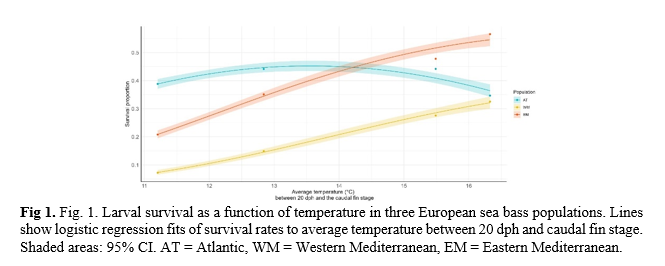GENOMIC ADMIXTURE AND LOCAL THERMAL ADAPTATION SHAPE LARVAL SURVIVAL IN EUROPEAN SEA BASS: IMPLICATIONS FOR SELECTIVE BREEDING UNDER CLIMATE CHANGE
Introduction
The European sea bass (Dicentrarchus labrax) is a key species of Mediterranean aquaculture and has undergone rapid domestication and selective breeding in the past two decades (Vandeputte et al., 2019). European sea bass breeding programmes are based on genetic resources gathered from three remarkable populations, Atlantic (AT), Western Mediterranean (WM), and Eastern Mediterranean (EM), formed through historical isolation, from which emerged two ancestral lineages (Atlantic - ATL, and Mediterranean - MED), followed by a secondary contact (Duranton et al., 2018). These populations characterized by a gradient genomic introgression between the two ancestral lineages, are differentially adapted to regional temperatures. Such introgression variation may impact larval fitness and complicate selective breeding strategies under shifting climatic conditions.
Materials and Methods
Using a common garden design, we reared ~57,600 larvae from AT, WM, and EM origins under four thermal regimes (rAT, rWM, rEM, and rAQUA) mimicking natural and hatchery environments. Over 6,200 juveniles were genotyped with a 57K SNP array (Griot et al., 2021), and ancestry was reconstructed via admixture (Alexander et al., 2009) and APIS (Griot et al., 2020). Parental ATL ancestry was used to define high vs. low introgression groups (POP+ / POP−). Larval survival was analyzed using generalized linear and logistic models, including quadratic regression to estimate temperature optima.
Results and Discussion
The interaction between thermal regime and population origin had a highly significant effect on larval survival (P < 2.2×10⁻¹⁶), highlighting local thermal adaptation and genetic divergence among the three sea bass populations. AT larvae showed the highest survival in colder regimes (rAT and rWM), with an estimated thermal optimum of 13.6°C (Fig. 1). Conversely, EM larvae performed best in warmer regimes (rEM and rAQUA), with predicted optima near or above 17.8°C. These dome-shaped thermal reaction norms suggest divergent selection histories aligned with regional spawning periods and sea surface temperature profiles.
WM larvae consistently had the lowest survival across all regimes, with no clear optimum, likely due to high and heterogeneous genomic admixture causing outbreeding depression. These differences are unlikely to stem from egg size, larval length, or prey preference, and instead point toward disrupted genomic architecture or hybrid incompatibilities.
Introgression from the alternate lineage significantly impacted survival in both AT and EM populations. In AT, offspring from less introgressed parents (POP−, lower MED ancestry) had higher survival, especially under colder conditions. Similarly, EM larvae with lower Atlantic (ATL) ancestry survived better in warm regimes. Chi-squared tests and ancestry comparisons confirmed purging of the minor lineage, MED in AT and ATL in EM, highlighting directional selection against introgressed genomes and reduced hybrid fitness.
In WM, no such purging was detected, likely due to genome-wide saturation with introgressed tracts. This persistent admixture may prevent the elimination of maladaptive alleles, explaining WM’s poor survival even under its native thermal regime. These patterns align with previous studies reporting purifying selection against Atlantic ancestry in Mediterranean populations. (Duranton et al., 2018; Leitwein et al., 2025). From a breeding perspective, these findings question the use of WM-derived broodstock. While initial crosses may yield short-term heterosis, our results show that even low levels of introgression can reduce larval fitness in subsequent generations. The observed purging and divergent thermal optima support the strategic use of locally adapted, genomically coherent broodstock to enhance survival and robustness in selective breeding programs.
Funding
Research funded by the ANR FishNess project (ANR-21-CE20-0043) and by the French Ministry of the Sea (DGAMPA) under grant CRECHE.
References
Alexander, D.H., Novembre, J., Lange, K., 2009. Fast model-based estimation of ancestry in unrelated individuals. Genome Res 19, 1655–1664.
Duranton, M., Allal, F., Fraïsse, C., Bierne, N., Bonhomme, F., Gagnaire, P.-A., 2018. The origin and remolding of genomic islands of differentiation in the European sea bass. Nat Commun 9, 2518.
Griot, R., Allal, F., Brard‐Fudulea, S., Morvezen, R., Haffray, P., Phocas, F., Vandeputte, M., 2020. APIS: An auto‐adaptive parentage inference software that tolerates missing parents. Mol Ecol Resour 20, 579–590.
Griot, R., Allal, F., Phocas, F., Brard-Fudulea, S., Morvezen, R., Bestin, A., Haffray, P., François, Y., Morin, T., Poncet, C., Vergnet, A., Cariou, S., Brunier, J., Bruant, J.-S., Peyrou, B., Gagnaire, P.-A., Vandeputte, M., 2021. Genome-wide association studies for resistance to viral nervous necrosis in three populations of European sea bass (Dicentrarchus labrax) using a novel 57k SNP array DlabChip. Aquaculture 530, 735930.
Leitwein, M., Ernande, B., Vandeputte, M., Clota, F., Allal, F., 2025. Reduced fitness associated with introgression within the Western Mediterranean admixed population of European seabass. Evolution qpaf079.
Vandeputte, M., Gagnaire, P.-A., Allal, F., 2019. The European sea bass: a key marine fish model in the wild and in aquaculture. Animal genetics 50, 195–206.
